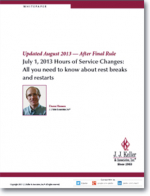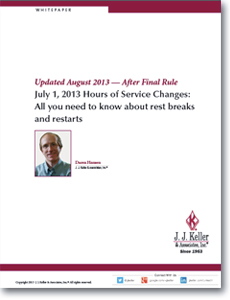Hours of Service Whitepaper
For many, the changes mean lower productivity, less flexibility, and higher costs, including training expenses.
Ready or not, changes have arrived to the U.S. federal hours-of-service (HOS) rules. Beginning July 1, 2013, most commercial truck drivers needed to start complying with new requirements for periodic rest breaks and new restrictions on use of the 34-hour “restart” option.
Why the changes? According to the Federal Motor Carrier Safety Administration (FMCSA), the revisions will help the hardest working drivers get more rest — both on a daily and weekly basis — thereby reducing fatigue and preventing accidents. Unfortunately for many, the changes also mean lower productivity, less flexibility, and higher costs, including training expenses.
Unless your drivers work less than 8 or 9 hours per day or are simply exempt from the new requirements, chances are your drivers’ schedules will need some adjusting. This whitepaper will examine the “who, what, when, where, and why” of the new HOS rules, plus provide some tips to make compliance easier and help manage your risk.
This whitepaper covers the critical issues surrounding the changes related to rest breaks and restarts:
- Who Has to Comply?
- Intrastate Variations
- "On Duty"
- Mandatory Breaks
- Restart Restrictions
- And much more
What’s Related

Favorites





